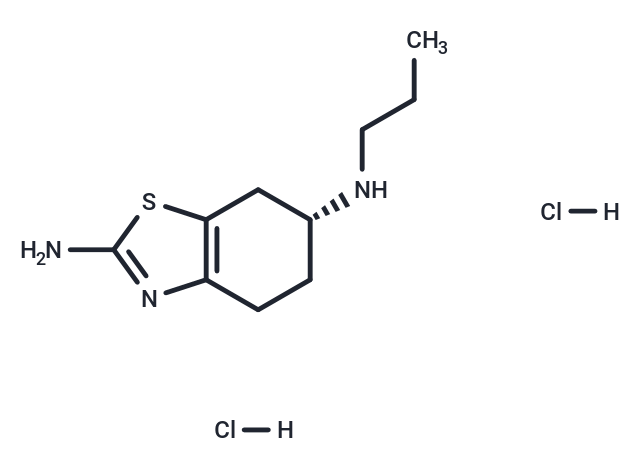Shopping Cart
- Remove All

Your shopping cart is currently empty


| Pack Size | Price | Availability | Quantity |
|---|---|---|---|
| 5 mg | $44 | In Stock | |
| 10 mg | $72 | In Stock | |
| 25 mg | $155 | In Stock | |
| 50 mg | $263 | In Stock | |
| 100 mg | $397 | In Stock | |
| 200 mg | $582 | In Stock | |
| 1 mL x 10 mM (in DMSO) | $48 | In Stock |
| Description | Dexpramipexole dihydrochloride (KNS-760704 dihydrochloride) ((R)-Pramipexole dihydrochloride) is a neuroprotective agent and is a weak non-ergoline dopamine agonist. |
| In vitro | Dextromethorphan has been found to have neuroprotective effects and is being studied for the treatment of amyotrophic lateral sclerosis (ALS). Dexpramipexole reduces mitochondrial reactive oxygen species (ROS) production, inhibits the activation of apoptosis pathways, and improves cell survival in response to various neurotoxins and β-amyloid neurotoxicity. Compared with the S-(-) isomer, dextromethorphan has lower dopamine agonist activity. |
| Alias | KNS-760704 dihydrochloride, R-(+)-Pramipexole dihydrochloride, (R)-Pramipexole dihydrochloride |
| Molecular Weight | 284.25 |
| Formula | C10H19Cl2N3S |
| Cas No. | 104632-27-1 |
| Storage | Powder: -20°C for 3 years | In solvent: -80°C for 1 year | |||||||||||||||||||||||||||||||||||
| Solubility Information | DMSO: 100 mg/mL (351.80 mM) H2O: 100 mg/mL (351.80 mM) | |||||||||||||||||||||||||||||||||||
Solution Preparation Table | ||||||||||||||||||||||||||||||||||||
DMSO
| ||||||||||||||||||||||||||||||||||||

Copyright © 2015-2024 TargetMol Chemicals Inc. All Rights Reserved.